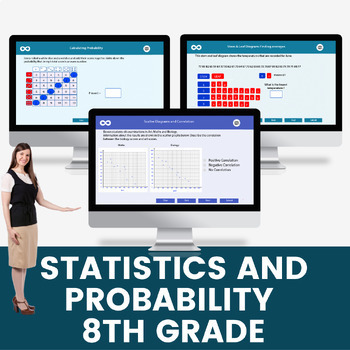Statistics and Probability Digital Math Lesson and Activities Bundle
Skoolmaths - Math Science ELA Resources
409 Followers
Grade Levels
7th - 8th, Homeschool
Subjects
Resource Type
Standards
CCSS7.SP.A.2
CCSS7.SP.B.3
CCSS7.SP.B.4
CCSS7.SP.C.5
CCSS7.SP.C.6
Formats Included
- Zip
- Internet Activities
- Easel Activity
Pages
100 Pages and Slides
Skoolmaths - Math Science ELA Resources
409 Followers
Easel Activities Included
Some resources in this bundle include ready-to-use interactive activities that students can complete on any device. Easel by TPT is free to use! Learn more.
Compatible with Digital Devices
The Teacher-Author has indicated that this resource can be used for device-based learning.
Products in this Bundle (9)
showing 1-5 of 9 products
Description
This amazing 8th Grade Statistics and Probability Digital Math Lesson and Activities is all you need for your 8th grade math class. From calculating averages using frequency tables to conditional probability, your learners are definitely going to be immersed in their learning! Buy this high-engagement math bundle today and save hours of lesson planning time.
Interactive Digital lessons inside this bundle include:
- Measures of Central Tendencies
- Conditional Probability - Venn Diagrams
- Conditional Probability - Two-way tables
- Probability scale
- Sample Space Diagrams and Probability
- Scatter Plots
- Lines of Best Fit and Correlation
- Stem and Leaf Diagrams
- Histograms
- Box Plots
Printable worksheets inside this bundle include:
- Box and Whisker plots (PDF and Easel Activities)
- Conditional Probability - Two-way tables (PDF and Easel Activities)
Total Pages
100 Pages and Slides
Answer Key
Included
Teaching Duration
N/A
Last updated May 1st, 2023
Report this resource to TPT
Reported resources will be reviewed by our team. Report this resource to let us know if this resource violates TPT’s content guidelines.
Standards
to see state-specific standards (only available in the US).
CCSS7.SP.A.2
Use data from a random sample to draw inferences about a population with an unknown characteristic of interest. Generate multiple samples (or simulated samples) of the same size to gauge the variation in estimates or predictions. For example, estimate the mean word length in a book by randomly sampling words from the book; predict the winner of a school election based on randomly sampled survey data. Gauge how far off the estimate or prediction might be.
CCSS7.SP.B.3
Informally assess the degree of visual overlap of two numerical data distributions with similar variabilities, measuring the difference between the centers by expressing it as a multiple of a measure of variability. For example, the mean height of players on the basketball team is 10 cm greater than the mean height of players on the soccer team, about twice the variability (mean absolute deviation) on either team; on a dot plot, the separation between the two distributions of heights is noticeable.
CCSS7.SP.B.4
Use measures of center and measures of variability for numerical data from random samples to draw informal comparative inferences about two populations. For example, decide whether the words in a chapter of a seventh-grade science book are generally longer than the words in a chapter of a fourth-grade science book.
CCSS7.SP.C.5
Understand that the probability of a chance event is a number between 0 and 1 that expresses the likelihood of the event occurring. Larger numbers indicate greater likelihood. A probability near 0 indicates an unlikely event, a probability around 1/2 indicates an event that is neither unlikely nor likely, and a probability near 1 indicates a likely event.
CCSS7.SP.C.6
Approximate the probability of a chance event by collecting data on the chance process that produces it and observing its long-run relative frequency, and predict the approximate relative frequency given the probability. For example, when rolling a number cube 600 times, predict that a 3 or 6 would be rolled roughly 200 times, but probably not exactly 200 times.





